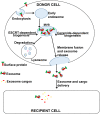Biological Activities of Extracellular Vesicles and Their Cargos from Bovine and Human Milk in Humans and Implications for Infants
- PMID: 27852870
- PMCID: PMC5177735
- DOI: 10.3945/jn.116.238949
Biological Activities of Extracellular Vesicles and Their Cargos from Bovine and Human Milk in Humans and Implications for Infants
Abstract
Extracellular vesicles (EVs) in milk harbor a variety of compounds, including lipids, proteins, noncoding RNAs, and mRNAs. Among the various classes of EVs, exosomes are of particular interest, because cargo sorting in exosomes is a regulated, nonrandom process and exosomes play essential roles in cell-to-cell communication. Encapsulation in exosomes confers protection against enzymatic and nonenzymatic degradation of cargos and provides a pathway for cellular uptake of cargos by endocytosis of exosomes. Compelling evidence suggests that exosomes in bovine milk are transported by intestinal cells, vascular endothelial cells, and macrophages in human and rodent cell cultures, and bovine-milk exosomes are delivered to peripheral tissues in mice. Evidence also suggests that cargos in bovine-milk exosomes, in particular RNAs, are delivered to circulating immune cells in humans. Some microRNAs and mRNAs in bovine-milk exosomes may regulate the expression of human genes and be translated into protein, respectively. Some exosome cargos are quantitatively minor in the diet compared with endogenous synthesis. However, noncanonical pathways have been identified through which low concentrations of dietary microRNAs may alter gene expression, such as the accumulation of exosomes in the immune cell microenvironment and the binding of microRNAs to Toll-like receptors. Phenotypes observed in infant-feeding studies include higher Mental Developmental Index, Psychomotor Development Index, and Preschool Language Scale-3 scores in breastfed infants than in those fed various formulas. In mice, supplementation with plant-derived MIR-2911 improved the antiviral response compared with controls. Porcine-milk exosomes promote the proliferation of intestinal cells in mice. This article discusses the above-mentioned advances in research concerning milk exosomes and their cargos in human nutrition. Implications for infant nutrition are emphasized, where permitted, but data in infants are limited.
Keywords: biological activity; bovine milk; exosomes; extracellular vesicles; human milk; infants; microRNA; noncoding RNA.
© 2017 American Society for Nutrition.
Conflict of interest statement
2 Author disclosures: J Zempleni, A Aguilar-Lozano, M Sadri, S Sukreet, S Manca, D Wu, F Zhou, and E Mutai, no conflicts of interest.
Figures


Similar articles
-
Concentrations of Purine Metabolites Are Elevated in Fluids from Adults and Infants and in Livers from Mice Fed Diets Depleted of Bovine Milk Exosomes and their RNA Cargos.J Nutr. 2018 Dec 1;148(12):1886-1894. doi: 10.1093/jn/nxy223. J Nutr. 2018. PMID: 30517726 Free PMC article.
-
Storage of Extracellular Vesicles in Human Milk, and MicroRNA Profiles in Human Milk Exosomes and Infant Formulas.J Pediatr Gastroenterol Nutr. 2019 Aug;69(2):235-238. doi: 10.1097/MPG.0000000000002363. J Pediatr Gastroenterol Nutr. 2019. PMID: 31169664 Free PMC article.
-
Milk-Derived Exosomes and Metabolic Regulation.Annu Rev Anim Biosci. 2019 Feb 15;7:245-262. doi: 10.1146/annurev-animal-020518-115300. Epub 2018 Oct 4. Annu Rev Anim Biosci. 2019. PMID: 30285461 Review.
-
The Intestinal Transport of Bovine Milk Exosomes Is Mediated by Endocytosis in Human Colon Carcinoma Caco-2 Cells and Rat Small Intestinal IEC-6 Cells.J Nutr. 2015 Oct;145(10):2201-6. doi: 10.3945/jn.115.218586. Epub 2015 Aug 12. J Nutr. 2015. PMID: 26269243 Free PMC article.
-
Beneficial Effects of Bovine Milk Exosomes in Metabolic Interorgan Cross-Talk.Nutrients. 2022 Mar 30;14(7):1442. doi: 10.3390/nu14071442. Nutrients. 2022. PMID: 35406056 Free PMC article. Review.
Cited by
-
Multifaceted effects of milk-exosomes (Mi-Exo) as a modulator of scar-free wound healing.Nanoscale Adv. 2020 Nov 30;3(2):528-537. doi: 10.1039/d0na00665c. eCollection 2021 Jan 26. Nanoscale Adv. 2020. PMID: 36131751 Free PMC article.
-
Extracellular Vesicles as Innovative Tool for Diagnosis, Regeneration and Protection against Neurological Damage.Int J Mol Sci. 2020 Sep 18;21(18):6859. doi: 10.3390/ijms21186859. Int J Mol Sci. 2020. PMID: 32962107 Free PMC article. Review.
-
Dietary-Derived Exosome-like Nanoparticles as Bacterial Modulators: Beyond MicroRNAs.Nutrients. 2023 Mar 3;15(5):1265. doi: 10.3390/nu15051265. Nutrients. 2023. PMID: 36904264 Free PMC article. Review.
-
Human Breast Milk: From Food to Active Immune Response With Disease Protection in Infants and Mothers.Front Immunol. 2022 Apr 5;13:849012. doi: 10.3389/fimmu.2022.849012. eCollection 2022. Front Immunol. 2022. PMID: 35450064 Free PMC article. Review.
-
Objecthood, Agency and Mutualism in Valenced Farm Animal Environments.Animals (Basel). 2018 Apr 3;8(4):50. doi: 10.3390/ani8040050. Animals (Basel). 2018. PMID: 29614016 Free PMC article. Review.
References
-
- Eidelman AI. Breastfeeding and the use of human milk: an analysis of the American Academy of Pediatrics 2012 Breastfeeding Policy Statement. Breastfeed Med 2012;7:323–4. - PubMed
-
- CDC. CDC national immunization surveys. Breastfeeding among U.S. children born 2002–2012. 2015 [database on the Internet; cited 2016 Jul 4]. Available from: http://www.cdc.gov/breastfeeding/data/nis_data/index.htm.
-
- US Department of Health and Human Services, National Institute of Environmental Health and Safety. Soy infant formula. Research Triangle Park (NC); 2013 [cited 2013 Nov 7]. Available from: http://www.niehs.nih.gov/health/topics/agents/sya-soy-formula/.
Publication types
MeSH terms
Grants and funding
LinkOut - more resources
Full Text Sources
Other Literature Sources

